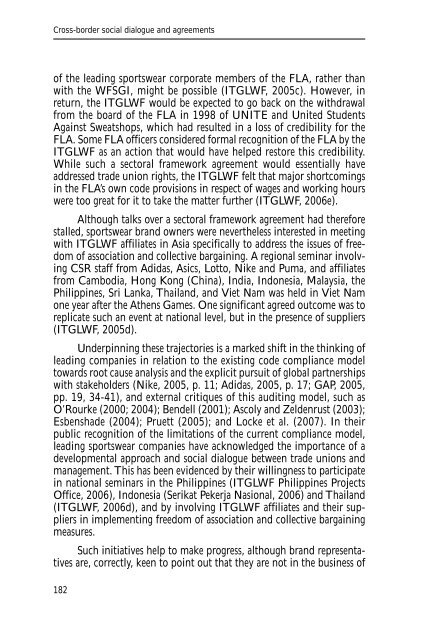CROSS-BORDER SOCIAL DIALOGUE AND AGREEMENTS: An ...
CROSS-BORDER SOCIAL DIALOGUE AND AGREEMENTS: An ...
CROSS-BORDER SOCIAL DIALOGUE AND AGREEMENTS: An ...
You also want an ePaper? Increase the reach of your titles
YUMPU automatically turns print PDFs into web optimized ePapers that Google loves.
Cross-border social dialogue and agreements<br />
of the leading sportswear corporate members of the FLA, rather than<br />
with the WFSGI, might be possible (ITGLWF, 2005c). However, in<br />
return, the ITGLWF would be expected to go back on the withdrawal<br />
from the board of the FLA in 1998 of UNITE and United Students<br />
Against Sweatshops, which had resulted in a loss of credibility for the<br />
FLA. Some FLA officers considered formal recognition of the FLA by the<br />
ITGLWF as an action that would have helped restore this credibility.<br />
While such a sectoral framework agreement would essentially have<br />
addressed trade union rights, the ITGLWF felt that major shortcomings<br />
in the FLA’s own code provisions in respect of wages and working hours<br />
were too great for it to take the matter further (ITGLWF, 2006e).<br />
Although talks over a sectoral framework agreement had therefore<br />
stalled, sportswear brand owners were nevertheless interested in meeting<br />
with ITGLWF affiliates in Asia specifically to address the issues of freedom<br />
of association and collective bargaining. A regional seminar involving<br />
CSR staff from Adidas, Asics, Lotto, Nike and Puma, and affiliates<br />
from Cambodia, Hong Kong (China), India, Indonesia, Malaysia, the<br />
Philippines, Sri Lanka, Thailand, and Viet Nam was held in Viet Nam<br />
one year after the Athens Games. One significant agreed outcome was to<br />
replicate such an event at national level, but in the presence of suppliers<br />
(ITGLWF, 2005d).<br />
Underpinning these trajectories is a marked shift in the thinking of<br />
leading companies in relation to the existing code compliance model<br />
towards root cause analysis and the explicit pursuit of global partnerships<br />
with stakeholders (Nike, 2005, p. 11; Adidas, 2005, p. 17; GAP, 2005,<br />
pp. 19, 34-41), and external critiques of this auditing model, such as<br />
O’Rourke (2000; 2004); Bendell (2001); Ascoly and Zeldenrust (2003);<br />
Esbenshade (2004); Pruett (2005); and Locke et al. (2007). In their<br />
public recognition of the limitations of the current compliance model,<br />
leading sportswear companies have acknowledged the importance of a<br />
developmental approach and social dialogue between trade unions and<br />
management. This has been evidenced by their willingness to participate<br />
in national seminars in the Philippines (ITGLWF Philippines Projects<br />
Office, 2006), Indonesia (Serikat Pekerja Nasional, 2006) and Thailand<br />
(ITGLWF, 2006d), and by involving ITGLWF affiliates and their suppliers<br />
in implementing freedom of association and collective bargaining<br />
measures.<br />
Such initiatives help to make progress, although brand representatives<br />
are, correctly, keen to point out that they are not in the business of<br />
182
















